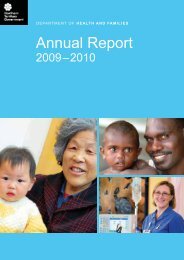PCD Strategy Evaluation 2007.pdf - NT Health Digital Library ...
PCD Strategy Evaluation 2007.pdf - NT Health Digital Library ...
PCD Strategy Evaluation 2007.pdf - NT Health Digital Library ...
You also want an ePaper? Increase the reach of your titles
YUMPU automatically turns print PDFs into web optimized ePapers that Google loves.
cent compared with five per cent). Three-quarters of the sedentary men described themselves asactive, compared with 19 per cent of women. Seventy-eight percent of the insufficiently activemen considered themselves active, compared with 58 per cent of the women.ObesityAdultsIn the 2000 AUSDIAB study, 58.3 per cent of the Northern Territory non-indigenous AusDiabparticipants were classified as either overweight (BMI 25-29.9) or obese (BMI 30). The rate formales was 68.0 per cent and for females, 47.2 per cent. The rate for overweight was 45.5 percent in males and 29.9 per cent in females. The overall prevalence of overweight individuals inthe Northern Territory AusDiab sample was 38.2 per cent. The prevalence of obesity was 22.5per cent in males and 17.3 per cent in females. The total prevalence of obesity was 20.1 percent. The 2006 AusDiab report does not differentiate states and Territories and we cannottherefore compare improvements in these data.ChildrenIncreasing childhood overweight and obesity is recognised as a significant problem in Australia.The proportion of <strong>NT</strong> urban children who are overweight is slightly lower at 12 per centcompared with South Australian children at 14.4 per cent. More <strong>NT</strong> urban Indigenous children areobese - 6.5 per cent than <strong>NT</strong> urban non-Indigenous children - 3.6 per cent and South Australianchildren 4.9 per cent. The proportion of remote Indigenous children who are overweight is 4 percent and there are no obese remote Indigenous children (3) . A future consequence may beincreasing rates of chronic disease amongst urban Aboriginal people.Figure 5.7 Overweight and obesity in 4-6 year old children in the <strong>NT</strong> and SA 2004 (3)Per cent20Overw eightObese151050<strong>NT</strong> Urban Indigenous<strong>NT</strong> Urban non-Indigenous<strong>NT</strong> RemoteIndigenousSouth AustraliaChapter 5: Key Result Areas – <strong>Evaluation</strong> of the <strong>NT</strong> Preventable Chronic Disease <strong>Strategy</strong> 2007 88
















